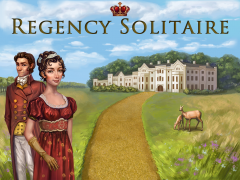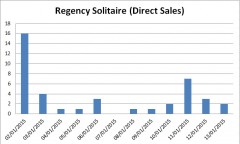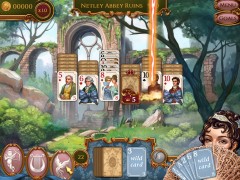
As well as using distributors to sell Regency Solitaire (for PC/Mac), I also sell it direct on this site.
When I sell direct to a customer I receive about 90% of the price paid (excluding sales taxes/VAT) and the payment provider gets about 10%.
However, when I sell via a casual game distributor most of them only pay me about 35% (some less, some a bit more), which is pretty lame, especially compared to Valve who pay developers 70% of games sold on Steam. Unfortunately, none of my games are on Steam (yet), RARRR!
So naturally I encourage people to buy direct from indies whenever possible as it really does make a HUGE difference.
If all the games I sold last year were bought directly from this site, instead of 99% via distributors then my financial situation would by wildly different. Instead of failing to pay myself a salary in December, I’d probably have paid off my mortgage instead. That’s the reality of it.
What can YOU do about it?
Well, if you are a customer, please consider buying direct from the developer! It really makes a big difference. Heck if you buy your vegetables and meat from local farmers, then do the same for indies 🙂
If you are a developer, are you selling direct? If not, why not? It’s not hard to do, and if you send all your potential customers to Steam or wherever then you are basically making it harder for yourself *and* other indies to survive (by teaching customers that you don’t really care about direct sales). Why would you do that?
First 12 days of sales
OK so how are my direct sales for my latest game so far? Basically shockingly low. Definitely not enough to live on (we spent a year making this game and also spent quite a lot on art and music).
Luckily the game is doing great on iWin (a casual game distributor) and will be on sale on other distributors soon where I expect it to do well – so we won’t go broke hopefully. It’s a shame that I need distributors to survive but I most definitely do because that’s the way most people have been trained to buy games now.

(click image to enlarge)
40 sales in 12 days. The game is $9.99 and I get about $8.74 of that after payment provider fees. So total revenue is approximately $350.
You might think $350 in 12 days is good, and it would be OK if it continued like that for the rest of the year, but it won’t. This is the launch spike and very soon sales will drop to just a couple of units A MONTH.
Newsletter Stats and Existing Customers
I tracked a few interesting things about those sales. Numbers are low, so not great for reliable statistics, but some interesting factoids can still be gleaned.
I sent out a newsletter on launch day, here are the stats:
Sent = 425
Bounce+unsubscribe = 8 (2%)
Opened = 178 (42%)
Clicked = 65 (15%)
And of the 40 sales so far, 12 were from existing customers, so:
Sales = 12 (2.8% of total or 6.7% of opened or 18% of clicked)
It’s possible some of those existing customers heard about the game via my Facebook page or some other means, but I don’t track that. So all I can say is that at *most* my newsletter converted 2.8% of recipients into buyers.
– On day 1 I made 16 sales and 9 (56%) were from existing customers.
– On day 2 I made 4 sales and 2 (50%) were from existing customers.
– Since then I’ve made 20 more sales and only 1 (5%) was from an existing customer.
I believe that sales from existing customers dwindled pretty rapidly and the remaining sales are mostly from the small amount of press that the game got, which I’ll go into in a minute. I think if I didn’t get that press, then sales would have dropped to pretty much zero.
Total sales from existing customers = 12 out of 40 total, so 30%.
This pattern is similar for previous game launches where I’ve sent out a newsletter to my newsletter subscribers.
It’s super-important to maintain a mailing list if you sell direct because selling to existing customers is easy and effective (it’s like the no.1 rule of marketing) – of course that means you have to stay in business long enough to keep making new games.
Refunds
I got 2 refunds out of 42 sales (=5%).
One was because the customer’s email program/browser/anti-virus told her the download site wasn’t safe. This isn’t true of course but she couldn’t be persuaded otherwise. This is a common reason for a refund. The other person thought they were buying a CD not a download for some reason, and didn’t want a download. OK then.
I operate a no quibbles refund policy because it’s easier (and better customer service) than getting into arguments with customers.
Marketing and Press
My wife and I have done a whole bunch of marketing-related activities for Regency Solitaire including Facebook, Twitter, Pintrest, press releases, contacting youtubers, forum posts etc. Was it worth it? No. But we do it anyway because we’ve got to try.
We did get a couple of good articles: one on Kill Screen and one on JayIsGames. We are hoping for more too over time as our efforts pay off.
The second small spike correlates with the JayIsGames article and hopefully it’ll keep a trickle coming in over time.
The main problem we, and many indies face, is getting *any* press at all. It’s extra tricky for us because we are making casual games and most of the gaming press and youtubers only cover “mainstream” games, not casual games.
“Casual” games is kind of a dirty word in some circles, which is a shame, and it’s further been sullied by all the free to play casual games on mobile. In fact, these days when I say I make casual games, often people automatically assume I make mobile games. Only old skool devs/customers know I mean downloadable PC/Mac games.
Also casual games are mostly played by women aged 30-70 (up to 90% on some sites.) I know this because I’ve seen numerous large surveys of casual game players over the years. Some casual gamers play games *way* more hours per week than “hardcore” gamers. In fact, one of our testers sat down and beat our entire game in a single 12 hour marathon according to my metrics.
Casual games often have a strong female protagonist too. This is something that the mainstream gaming press seems to be constantly searching for in the name of diversity (largely in vain) in mainstream AAA games, with indies occasionally delivering the goods. However, if the press just took a look casual games more often, they’d find games for women starring women (of course men can play them too, I do!)
Oops, sorry about the rant, anyway…
TL;DR
– Not enough indies sell direct, and they should do!
– Customers have been trained over the years to buy from distributors instead of buying direct, and that sucks.
– My direct sales suck, though I am grateful for every single one of them.
– There are some really great casual games out there. I wish the press/youtubers didn’t ignore them.
– Please buy Regency Solitaire DIRECT from us today. Thanks!















